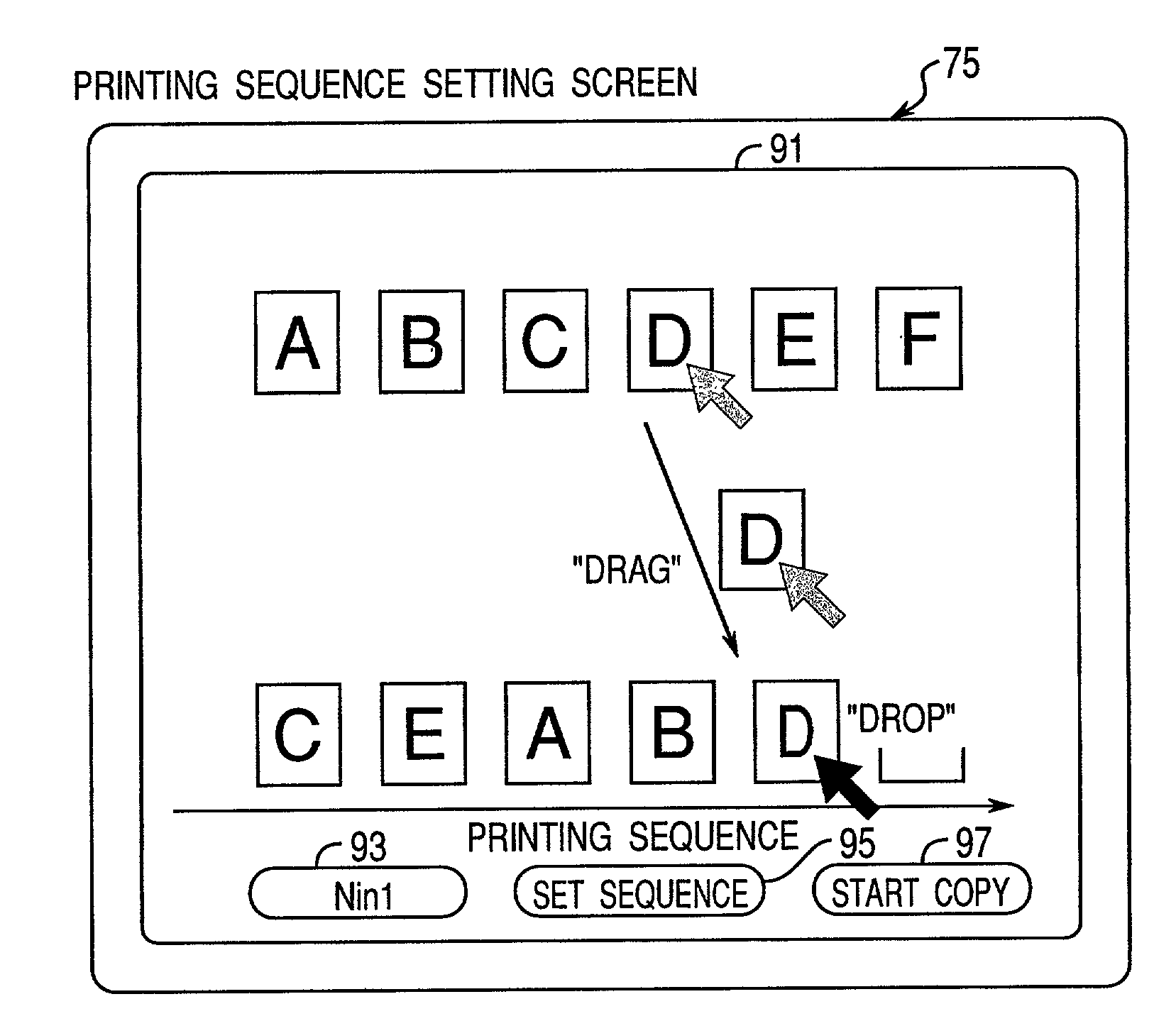Image processing system for outputting scanned images in the specified sequences
a processing system and sequence technology, applied in the direction of digital output to print units, visual presentations, instruments, etc., can solve the problems of increasing time and effort required to complete these tasks, complicated reordering requirements, and increasing complexity, so as to achieve the effect of easy definition by the user
- Summary
- Abstract
- Description
- Claims
- Application Information
AI Technical Summary
Benefits of technology
Problems solved by technology
Method used
Image
Examples
embodiment 1
(Embodiment 1)
[0039]An image processing system according to a first preferred embodiment of the present invention is shown in FIG. 1. As shown in FIG. 1, this image processing system comprises a photocopier 1 and an information processor 2 connected to the photocopier 1.
[0040]The photocopier 1 comprises a scanner unit 10 for scanning and capturing an image of a document, and a printer unit 40 for printing the scanned image to produce a hard copy reproduction of the original document.
[0041]The scanner unit 10 operates as a data source to generate print data, and comprises a CPU 11 for running a predetermined program to control the scanner unit 10 and the printer unit 40, an control panel 13 whereby the user specifies various settings and can confirm the photocopier 1 status, an automatic document feeder (ADF) 15, an image reader 17 for scanning and reading an image of a document supplied from the ADF 15, an image processing unit 19 for applying a specific image process to the read im...
embodiment 2
(Embodiment 2)
[0110]FIG. 20 is a block diagram of an image processing system according to a second preferred embodiment of the invention. As shown in FIG. 20, the scanner unit 10 and the printer unit 40 integrated into the photocopier 1 in the first embodiment shown in FIG. 1 are separated to a discrete scanner 10b and printer 40b. The scanner 10b is connected via a video interface 27 to the printer 40b, and via a serial interface 25 to an information processor 2. Images captured by the scanner 10b can thus be output to the printer 40b and / or the information processor 2 by means of these interfaces 27 and 25.
[0111]The scanner 10b shown in FIG. 20 is substantially identical to the scanner unit 10 shown in FIG. 1, but additionally comprises a display 75b for presenting the printing sequence setting screen, and a pointing device 77b such as a mouse for selecting the output sequence. In addition to the programs for accomplishing the control defined in the flow charts in FIGS. 10 to 15, ...
embodiment 3
(Embodiment 3)
[0117]FIG. 21 is a flow chart of an alternative embodiment of the image scanning process (S52) and the compression and thumbnail image generation process (S53) shown in the flow chart in FIG. 11.
[0118]As shown in FIG. 21, the first step in this process is to determine whether scanning by the image reader 17 has finished (S171). When not, one scanning line of the image is captured by the image reader 17 (S172), and the captured image signal is A / D (Analog to Digital) converted to a multivalued digital signal (S173). A counter m, which is initialized to zero (0), is then incremented by 1 (S174). It is then determined whether the counter m is equal to a predetermined value, which is the number of scanning lines in this embodiment (S175).
[0119]When the counter m does not equal the predetermined value (“NO” in step S175), the A / D converted multivalued signal is binarized to a two-valued signal (S180), and then compressed (S181). The compressed data is then stored to RAM 21 ...
PUM
 Login to View More
Login to View More Abstract
Description
Claims
Application Information
 Login to View More
Login to View More - R&D
- Intellectual Property
- Life Sciences
- Materials
- Tech Scout
- Unparalleled Data Quality
- Higher Quality Content
- 60% Fewer Hallucinations
Browse by: Latest US Patents, China's latest patents, Technical Efficacy Thesaurus, Application Domain, Technology Topic, Popular Technical Reports.
© 2025 PatSnap. All rights reserved.Legal|Privacy policy|Modern Slavery Act Transparency Statement|Sitemap|About US| Contact US: help@patsnap.com



